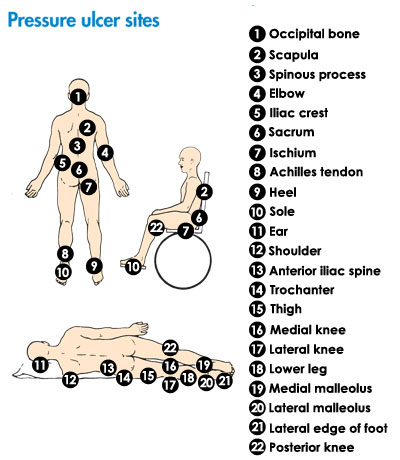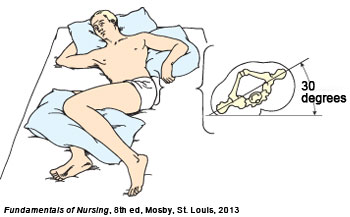What to Do

Look at the Skin
Look at the person’s skin daily, especially if they are at risk for a pressure ulcer. The easiest time to do this is before or during a bath, in the morning when the person first awakens or just before the person goes to bed.
- Look at all skin surfaces, especially those over bony points on the body, such as the heels, tailbone, ears, side of the ankles and knees.
- There is an easy test to check for early pressure. When you see an area of redness on the skin, take your finger and gently press against the skin, making a fingerprint. Normally the skin color will lighten but then the color returns to red when you remove your finger. This is called blanching.
- If the skin blanches there is no injury from pressure.
- If the skin does not blanch, this is an early sign of a pressure ulcer.
- Keep an eye on any area of redness.
- If the redness stays for more than a day, or a skin tear or abrasion does not heal in 3 to 4 days, you need to call the person’s doctor
Cleanse the Skin
- Bathe a person’s skin regularly, using mild soap and water. Dry the skin thoroughly after bathing. Older adults have very dry skin and often only need a bath once or twice a week.
- Use a lubricating lotion on the skin. A brisk light rub will increase blood supply to the skin. The lotion needs to be absorbed so it doesn’t leave the skin moist, allowing bacteria to grow. This is a preventive measure. Warning: If the skin is red or there is an open wound, do not rub the area.
- If urine or liquid from a bowel movement gets on the skin, clean the skin as soon as you can. Use of skin protectant creams may protect the skin when the person is having diarrhea or is unable to control his or her urine or bowel movements.
Relieve Pressure

- Do not let a person sit or lie in one position for a long time. Have the person turn and reposition in bed at least every 2 hours and turn and reposition in a chair every 15 to 20 minutes.
- When positioning a person on their side it is best that he or she lie in the 30 degree side-lying position. The person’s head stays below a 30 degree angle. Also, the hip that the person lays on is brought forward so less pressure is on the hip. Use pillows to keep the person in position. See our future Lesson on Positioning in Bed.
- Be sure a person does not lay over a tube or piece of equipment as this can place pressure on the skin.
- There are pressure relief devices or cushions for use on wheelchairs. Consult with your doctor or home health nurse on the type of device to use.
- Never use donut-type cushions or sheepskin on beds or chairs. These do not relieve pressure. In fact, they increase pressure over the skin.
- There are pressure relief mattresses for use on beds that will reduce pressure. Consult with your doctor or a home health nurse for the type of device to use. Usually you can rent a device through a home medical equipment company.
Eat a Healthy Diet
The person you care for should eat a healthy well-balanced diet. Skin heals best with an increase in protein (eggs, meat, cheese, beans), calories, Zinc, and Vitamin C.
Remove any Irritation on the Skin
When the skin is wet from sweat, urine, diarrheal stool, or drainage from a wound, cleanse the skin as soon as you can. The person’s doctor may recommend a type of ointment that will provide a moisture proof barrier.
Control Diarrhea – If a person has diarrhea, bathe the skin after each bowel movement and then dry thoroughly. Liquid diarrhea irritates the skin and over time can damage the outer layer of the skin. Always use clean disposable gloves when washing a person after a bowel movement and dispose of the gloves in a plastic garbage bag.
Ways to control diarrhea (Recommended by the National Cancer Institute, 2011):
- Have the person eat small meals that are easy to digest.
- Eat 5 or 6 small meals each day, instead of 3 big meals.
- Foods such as bananas, applesauce, white rice, and white toast are easy to digest.
- Have the person drink more liquids each day
- Drinking more won't stop the diarrhea, but it helps replace the fluids a person loses.
- A person with diarrhea needs to drink 8 to 12 cups (64 to 96 ounces) of liquid every day.
- Have the person stay away from foods that makes diarrhea worse:
- Don’t eat dairy products, such as milk, cheese, and sour cream.
- Don't eat spicy, greasy, or fried foods.
- Don't have foods that cause gas, such as broccoli and cabbage.
- Don't eat foods that are high in fiber, such as whole-wheat breads, granola, and bran cereals.
- Don't eat raw fruits or vegetables. Most canned fruits and vegetables are okay.
- Liquids that a person can drink include:
- Clear broth, such as chicken, vegetable, or beef
- Clear soda, such as ginger ale
- Cranberry or grape juice
- Rehydration drinks, such as Pedialyte®
- Tea (without caffeine)
- Water
- Meals and snacks a person can eat include:
- Applesauce, cottage cheese, Yogurt (plain or vanilla)
- Cream of Wheat® , oatmeal
- Gelatin (Jell-O®),
- White rice, Noodles
- Bananas
- Crackers, white toast
- Eggs
- Meats, such as chicken, fish, or turkey - broiled or baked, without the skin
- Creamy or smooth peanut butter
When a Pressure Ulcer Forms
If the person you care for develops a pressure ulcer, follow these steps:
Stage I ulcers
- Keep pressure off the ulcer, by turning and repositioning the person (See our future lesson on Positioning in Bed). Do not let the person lay or sit on an ulcer if possible.
- Wash the ulcer with mild soap and water, rinse well, and pat dry carefully (but gently). Do not rub directly over the ulcer or reddened area.
- Be sure you are using the right pressure relief devices (e.g. cushions or mattresses) on the wheelchair or bed.
- If the ulcer seems to be caused by friction, sometimes a protective transparent dressing such as Op-Site® or Tegaderm® (available in a variety of sizes) will protect the area by allowing the skin to slide easily.
- If the ulcer does not heal in a few days or returns, call the doctor.
Stage 2, 3 or 4 ulcers
- Follow the steps for care of a Stage I ulcer. Call the doctor for further treatment. You may be referred to a wound care specialist.